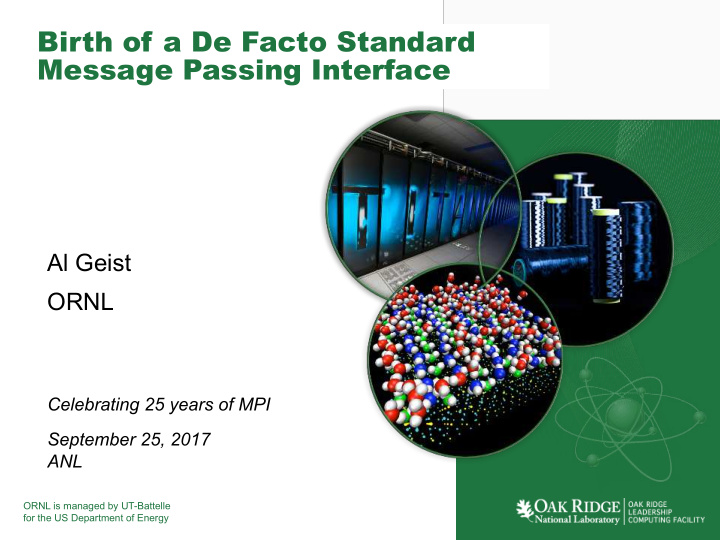



Birth of a De Facto Standard Message Passing Interface Al Geist ORNL Celebrating 25 years of MPI September 25, 2017 ANL ORNL is managed by UT-Battelle for the US Department of Energy
Birth of a De Facto Standard Or How I Stopped Worrying and Learned to Hate Dallas • In 1992 Jack, Rolf, and Tony hold a meeting to try to get vendors to adopt a single message passing standard. Some vendors want it to be PVM , but other vendors want it to be their personal API. – At this meeting it became clear that no existing API would be adopted. So the HPC community would have to collectively create a message passing interface that everyone could feel ownership of. • 1993 MPI 1.0 Forum meets in Dallas every 6 weeks Remember getting bussed to the hotel? for most of the year to create the MPI 1.0 API • 1995 MPI 2.0 Forum meets in Chicago airport every Just walked across 6 weeks for 2 years to create the MPI 2.0 API street at O’Hare 2
Couple Mid-wives help with the Birth MPI use grew, but didn’t become a de facto standard till around 2000 when its user base finally grew larger than PVM Dan Hitchcock (DOE CS program manager) and his boss Walt Polanski. Dan called me in 1998 at the peak of PVM use and said he was canceling all funding for PVM research – go do something else. And so we did, which helped MPI adoption and the establishment of a single de facto standard EuroPVM EuroPVM/MPI EuroMPI 3
Remember the MPI Shirts? MPI Don’t blame me I didn’t vote for that feature … The background is made up of all the MPI 1.0 functions You want a non-blocking what??? … 4
The MPI Non-Blocking Barrier • While folks in this room know why you want this function. The general user always looks at me like “The MPI Forum must be crazy” • The t-shirts reflect some of the feedback the community felt early on about MPI – The Monet t-shirt: Reflected the thing we often heard “MPI has way too many functions” – Don’t blame me. I didn’t vote for that feature. . . Reflected the many new concepts introduced by MPI that one has to use. – You want a non-blocking what? Reflected that we made sure there was a non-blocking version of everything – even the blocking function 5
When MPI is Your Hammer Every Problem Looks like a Thumb Marc Snir’s talk covers this: “MPI is too High-level; MPI is too Low-level” MPI give the users many ways to tackle their problems. Leave it to our creative users to find poor ways to use the MPI functions. 6
Failing to Define a Fault Tolerant MPI A Regret: That we were unable to define MPI to allow applications to “run through” faults rather than abort the entire parallel job when one node fails. Championed by Al Geist in MPI 1.0 and MPI 2.0 and by Rich Graham in MPI 3.0. For 25 years the MPI Forum has always voted this capability down It was a common complaint by users, but now they seem resigned to MPI’s behavior It was possible as demonstrated by UTK’s FT-MPI Research (and others) • Define the behavior of MPI in case an error occurs • Give the application the possibility to recover from a node-failure • Provide the notification to the application • Provide recovery options for the application to exploit if desired Aborting entire MPI job is a real problem given the resilience of existing systems (Seen this year on Titan) 7
MPI Too Big To Fail MPI is the dominant programming method used in todays HPC science apps 8
The Answer is MPI. What is the Question? Will MPI still be used at Petascale? What about at Exascale? Applications will continue to use MPI due to: • Inertia – these codes take decades to create and validate • Nothing better – developers need a BIG incentive to rewrite (not 50%) Communication libraries are being changed to exploit new HPC systems, giving applications more life. • Hardware support for MPI is pushing this out even further ? Can MPI Scale to Exascale? It was a serious topic in 2009 when we tried to launch the Exascale program 9
MPI can Scale to Exascale It was a serious topic in 2009 when we tried to launch the Exascale program Extreme-scale Simulator (X-Sim) developed by Christian Engelmann at ORNL to answer this question • In 2010 simulated an MPI app running on 1 million processors • In 2011 simulated an MPI app running on 100 million processors Simulator is a parallel application – Runs on a Linux Cluster Adjustable Topology – Configured at startup Supports Fortran, and C applications MPI app Scaling to 134,217,728 (2^27) simulated MPI ranks 10
MPI will be with us as we march to Exascale But will it be MPI 4.0 by then??? Yes! . . . according to Steve’s strait line graph 10 18 10 17 10 16 10 15 OLCF-5 Summit 5–10 × Summit ~30 MW 200 PF Titan: Hybrid GPU/CPU 27 PF Jaguar 15 MW Hybrid GPU/CPU 2.3 PF 9 MW Multi-core CPU 7 MW 2012 2017 2021 2010 11
Thanks 12
Recommend
More recommend